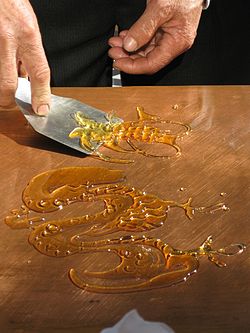Sugar painting is a traditional Chinese form of folk art using hot, liquid sugar to create two dimensional figures. This snack is popular among children. Selecting a figure is normally determined by spinning the arrow on a wheel.

History
Sugar painting may have originated during the Ming dynasty when small animals made of sugar were created in molds for religious rituals. This art form then became more popular during the Qing dynasty. After that period techniques improved, and a more diverse range of patterns emerged. In Sichuan, further developments were made in production, seeing the replacement of the molds with the now-common small ladle, often bronze or copper.
Technique
Although techniques vary, normally the hot sugar is drizzled from a small ladle onto a flat surface, usually white marble or metal. The outline is produced with a relatively thick stream of sugar. Then, supporting strands of thinner sugar are placed to attached the outline, and fill in the body of the figure. These supporting strands may be produced with swirls, zig-zags, or other patterns. Finally, when completed, a thin wooden stick, used to hold the figure, is attached in two or more places with more sugar. Then, while still warm and pliable, figure is removed from the surface using a spatula-like tool, and is sold to the waiting customer, or placed on display.
Figures
Popular figures include dragons, fishes, monkeys, dogs, birds, and flower baskets.





